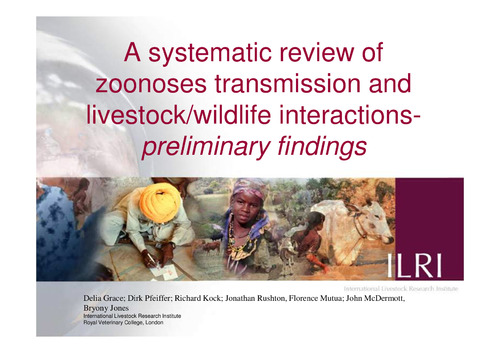A systematic review of zoonoses transmission and livestock/wildlife interactions: Preliminary findings
Abstract
Around 60% of all human pathogens are zoonoses and domestic animals and wildlife are of equal importance as reservoir
hosts. Moreover, most emerging infectious diseases are zoonoses and most emerge from wildlife. There have been several
recent initiatives to categorize zoonoses and their reservoirs but their socio-economic impact remains poorly defined and
previous reviews lacked both poverty and gender perspectives.
We present the initial findings of a multi-disciplinary, systematic review commissioned by the Department for International
Development (UK) to synthesize best available scientific knowledge about zoonotic disease transmission through direct or
indirect domestic livestock/wildlife interaction, with emphasis on risk factors, drivers and trajectories of transmission, and
promising interventions for controlling important zoonoses based on managing domestic livestock/wildlife interaction.
The review covers: zoonoses transmission and relative importance of the wildlife/livestock route; wildlife pathogens
capable of recombining with analogous organisms in domestic livestock; risk factors and drivers for zoonoses transmission
at the human/livestock/wildlife interface; historical changes in transmission and trends; livestock production systems as
primary drivers of zoonotic disease load in the environment and role of wildlife as amplifiers, spill-over/indicator hosts and
reservoirs; socio-economic, institutional and political factors influencing risk of transmission between wildlife and domestic
livestock and from wildlife/livestock to people; risk management and control interventions and their success or failure with
emphasis on interventions based on managing interaction between hosts (wildlife/livestock/humans).
This review summarizes best evidence on livestock/wildlife interactions and zoonoses transmission.

